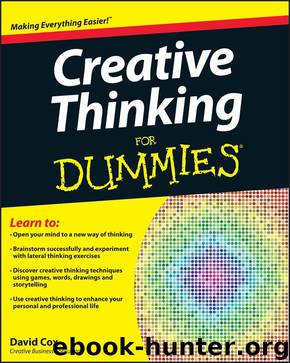Creative Thinking For Dummies by David Cox

Author:David Cox [Cox, David]
Language: eng
Format: azw3
Publisher: Wiley
Published: 2012-11-27T05:00:00+00:00
Chapter 8
Closing In on the Answer: Creative Problem-Solving
In This Chapter
Finding solutions through creativity
Being in character with the Disney model
Taking Young’s Five Steps
Dividing your brain with Herrmann’s model
One of the key areas of creative thinking is problem-solving. I talk about the first step, opening up, where the main purpose of the activity is generating ideas, in Chapter 7. This chapter focuses on the closing-in phase in which you aim to find a solution or perhaps make sense of a complex problem. If opening up is the imaginative phase of creative thinking, you can consider closing in to be the practical phase where you turn ideas into reality.
Many different techniques exist for helping you close in on solutions to a problem, so in this chapter I serve up several of the most effective. Some originated in the commercial world, but they’re equally effective when you’re working on a problem at home or in your personal life. So, whether you’re part of an international conglomerate driving towards the solution to a critical problem, or sitting at the kitchen table working out how to accomplish a task, the need to have a process for closing in on the solution is the same.
Working Creatively to Find a Solution
The process of working towards a solution can take many forms. Some systems are highly systematic and structured – step-by-step sequences of actions that follow specific routes. Others involve a looser, more flexible approach. There is no single right or wrong answer here. Both approaches have their merits in the right context, and both are more suited to some situations than others.
Both types of approach have common themes:
Preparation: What makes creative thinking so exciting for many is the electric charge of having the original idea. However good an idea, though, it only works if it becomes reality. Each of the methods described in this chapter places a premium on thorough preparation, analysis and research. Unless you really know your subject and have immersed yourself in it, you may find that the gap between idea and reality remains wide.
Exposure to criticism: Criticism is almost inevitable, so prepare yourself for it. Seeing criticism as part of the process that helps deliver your idea, and not just as a negative, is the best approach. Exposing your ideas to the cold light of day ultimately makes the surviving solution that much stronger.
Many professional thinkers spent their lives devising methods to find ways of focusing on their problems and delivering solutions. Among the contributions to this issue, some of the processes can seem simple. But it’s worth bearing in mind that in many cases the originators spent years evolving the effective strategies described here.
Using the Disney Model – Being in Character
A good starting point for looking at the problem-solving process is the model devised by Walt Disney, one of the creative giants of the twentieth century. He overcame several early failures and bankruptcy before creating the entertainment empire that bears his name.
Disney was a prolific creator who played a significant role in American culture.
Download
This site does not store any files on its server. We only index and link to content provided by other sites. Please contact the content providers to delete copyright contents if any and email us, we'll remove relevant links or contents immediately.
Big Magic: Creative Living Beyond Fear by Elizabeth Gilbert(5682)
Paper Towns by Green John(5142)
On Writing A Memoir of the Craft by Stephen King(4893)
The Doodle Revolution by Sunni Brown(4717)
Hyperfocus by Chris Bailey(4089)
Evolve Your Brain by Joe Dispenza(3635)
Unlabel: Selling You Without Selling Out by Marc Ecko(3630)
The Red Files by Lee Winter(3393)
Draw Your Day by Samantha Dion Baker(3322)
The Power of Mindful Learning by Ellen J. Langer(3202)
The Art of Dramatic Writing: Its Basis in the Creative Interpretation of Human Motives by Egri Lajos(3040)
The War Of Art by Steven Pressfield(2917)
Applied Empathy by Michael Ventura(2866)
The 46 Rules of Genius: An Innovator's Guide to Creativity (Voices That Matter) by Marty Neumeier(2820)
How to be More Interesting by Edward De Bono(2769)
Keep Going by Austin Kleon(2734)
Why I Am Not a Feminist by Jessa Crispin(2727)
How to Stop Worrying and Start Living by Dale Carnegie(2692)
You Are Not So Smart by David McRaney(2629)
